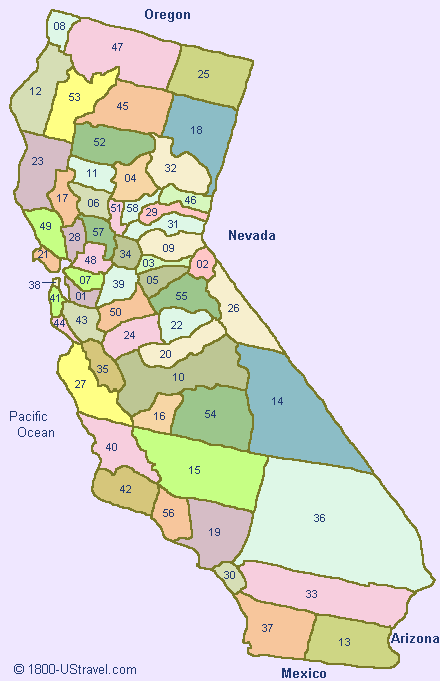California’s County System: Count, Roles, and Historical Growth
California’s County System: Count, Roles, and Historical Growth
Blog Article

Have you ever wondered how many counties are in California? You’d be surprised how many people ask the same question. Whether it’s for school projects, travel get more info plans, or simple trivia, the number 58 keeps popping up, butthose two digitsonly tells half the story.
The Golden State’s 58 counties createa tapestry of extremes: sun-drenched coastal hubs, high-elevation wilderness zones, fertile Central Valley breadbaskets, and historic mission settlements. None of these counties lacks a unique backstory, shaped by gold-rush dreams, promising new industries, and ever-changing demographics.
Over the next few pages, we’ll unpackthe timeline that locked the total at 58, the real responsibilities counties shoulder, and the outliers that set fascinating records. When we’re done, you’ll own the knowledge—and map your next California adventure with confidence.
County-Making in Early California
Upon admission to the United States, the map was a patchwork of just 27 jurisdictions. Rapid gold-rush immigration forced lawmakers to redraw borders. Before the century turned, the count had ballooned to 53 counties, and in 1907 the last adjustments were ratified, cementing the now-famous tally of 5 8.
Assembly journals reveal that most new counties sprang out of three overlapping forces:
- Hundreds of rugged miles turned routine business into week-long trips.
- Revenue battles pitting ranchers against merchants sparked break-ups.
- Ethnic enclaves wanted self-rule.
In less than seventy years, the political map hardened. In modern times, every effort to create county #59 stalls, leaving historians to label the era of county making a finished chapter.
Landscape and Climate Diversity Across California Counties
Plot a route from foggy Crescent City to sun-baked Imperial touching Mexico, and you’ll thread through dozens of ecosystems. Coastal counties enjoy Mediterranean precipitation, while interior giants like San Bernardino or Kern bank on irrigation.
- Alpine districts such as El Dorado, Tuolumne, and Sierra receive winter snows.
- River-delta territories balance peat islands and orchards.
- Channel-coast administrators like Santa Barbara manage marine sanctuaries.
Such variety explains how water rights, zoning, and ag yields diverge so sharply. Climate, after all, shapes crops and careers.
Behind the Scenes at the County Level
In California’s layered structure, municipalities handle zoning, but counties are tasked with crucial baseline services that hold civilisation together. Life’s paperwork trail—vital records, coroner reports, property deeds—all sit at the county clerk or recorder.
County law-enforcement offices patrol unincorporated land, while county benches hear civil suits. Health departments coordinate Medi-Cal. Tax-allocation showdowns fill chamber galleries with activists.
Spotlight: Los Angeles County’s Scale
Tiny Alpine operates from a single two-story courthouse, highlighting how adaptable the system is. There’s no single blueprint when land areas shift from 47 to 20 000 sq mi.
Ultimately, county offices translate state statutes into daily action. Grasping their portfolio guides newcomers navigating paperwork.
Demographic and Fiscal Highlights
Home to over 39 million residents, but that population is far from evenly spread. LA’s single jurisdiction packs nearly 25 %. At the other extreme, tiny Alpine County hovers around a thousand residents.
- Most populous: Los Angeles
- Smallest by residents: Alpine County
- Largest area: San Bernardino
- Compact footprint: San Francisco
Money, like people, concentrates and evaporates. South Bay enclaves report six-figure median incomes, while Central Valley breadbaskets depend on seasonal labour influxes. Such economic polarity informs legislative redistricting every decade.
Knowing which county tops which listis trivia gold: county metrics shape property taxes and commute times.
Touching All Counties in One Journey
County-collecting hobbyists, bagging all 58 jurisdictions ranks as a top geo-challenge. The classic route begins in sunny San Diego, rolls up the Pacific Coast Highway, swings through Monterey, then threads through the Central Valley’s orchard belt, before snaking into the Sierra Nevada for ghost towns and mining museums.
Three-Day County Clusters
- Southern Swing – Mission trail coast; ten jurisdictions in a long weekend of days.
- Heartland Stretch – Ventura to Sacramento; produce-market run.
- Shasta & Siskiyou Turn – mountain lakes and volcano cones; fire-lookout hikes.
Close the circuit in Imperial, with quadruple-digit odometer gains. After that, you can brag that you’ve lived the answer to the county-count question—because you’ve seen them all!
FAQ
Wondering how the county system works? Start with these quick answers.
How many counties are in California?
Government documents list fifty-eight counties—a number that hasn’t changed since 1907. Regardless of the source—be it Sacramento archives or federal census data: precisely fifty-eight.
Most populous California county?
Los Angeles County tops the list, hosting a population greater than that of many U.S. states. From Hollywood to high tech, a mix of industries continues to fuel steady inflow.
Which CA county has the fewest residents?
Alpine County holds that distinction, rarely crossing the 1 200-resident mark. Location along rugged mountain corridors limits large-scale development, making it a haven for solitude seekers.
What is California’s biggest county geographically?
Geographic titan San Bernardino County stretching more than 20 000 square miles. From Joshua trees to ski lifts, few regions illustrate California’s contrasts so vividly.
How did California end up with 58 counties?
Early statehood growth pressures split larger districts into smaller units, ending when Imperial County formed in 1907. While secession talk appears now and then, no plan has passed statewide hurdles.
Is it possible to form a 59th county?
Legally, yes—state law allows it, but the hurdles are steep. A break-off region must gather local signatures, win a majority vote in each affected county, and secure legislative approval. Consequently, boundaries have frozen for over a century.
Which responsibilities fall to county governments?
Behind the scenes, counties keep daily life functioning: property assessments, public hospitals, welfare programs, and jails. Remove counties from the equation, and civil society would struggle to operate.
Report this page